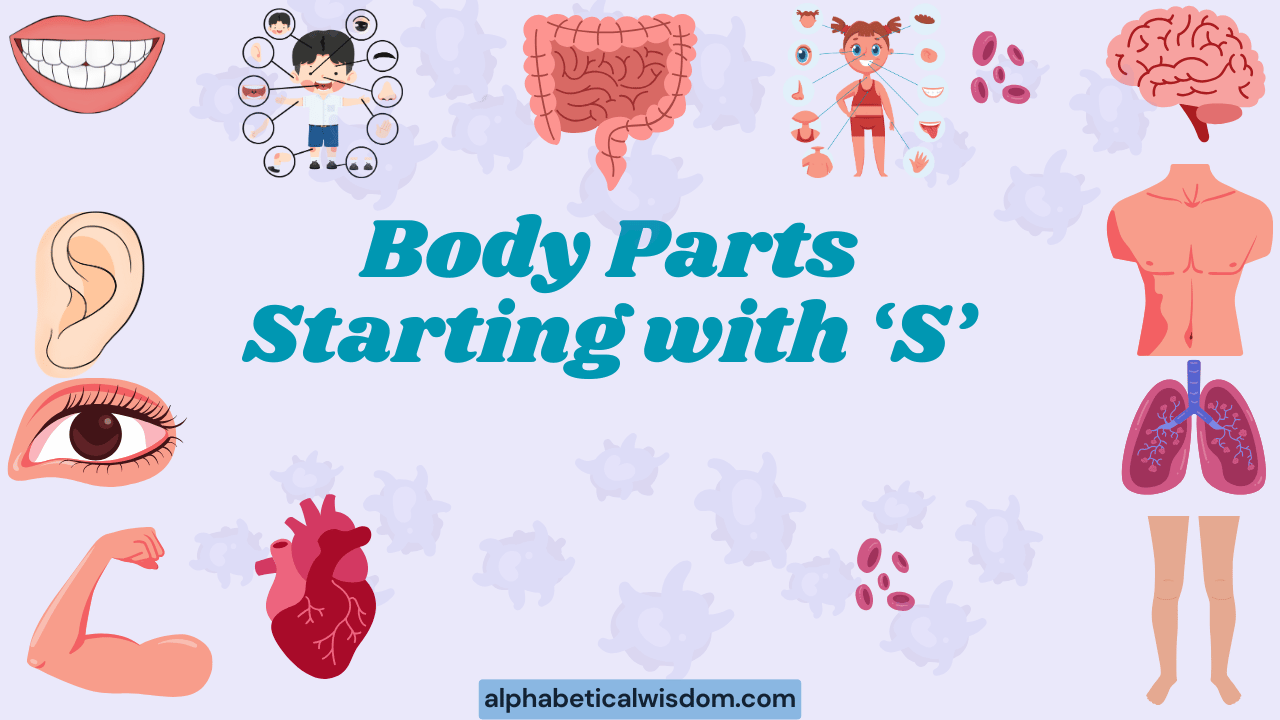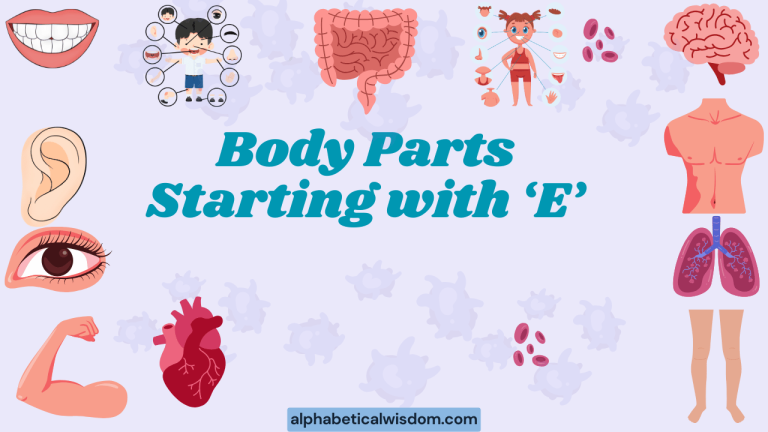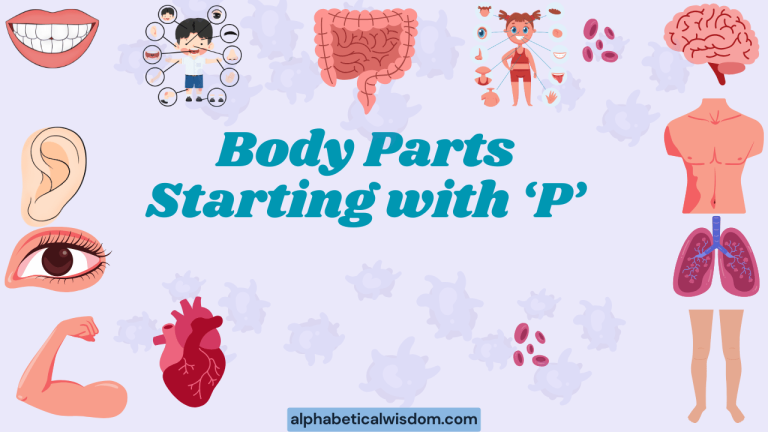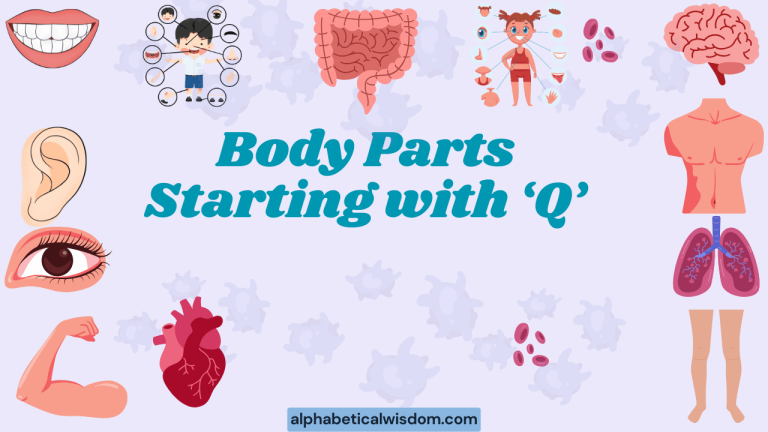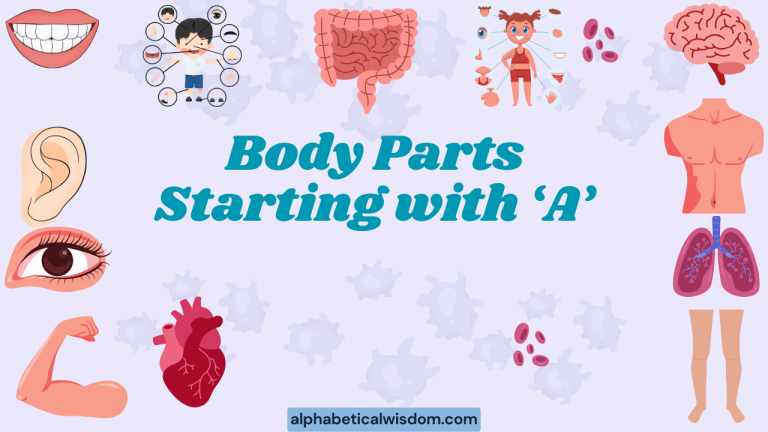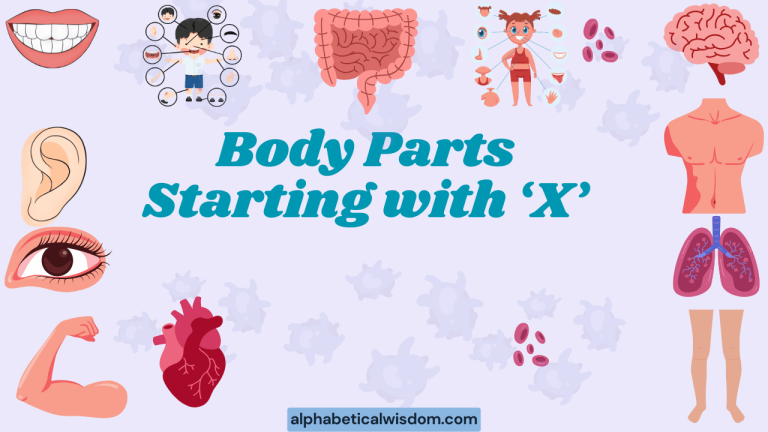Body Parts: Mastering Nouns Starting with ‘S’ in English
Understanding the vocabulary of body parts is crucial for effective communication in English. Focusing on nouns that begin with the letter ‘s’ enhances your ability to describe anatomy, discuss health, and engage in everyday conversations.
This article provides a comprehensive guide to body parts starting with ‘s,’ covering their definitions, usage, common mistakes, and practice exercises. Whether you’re an ESL learner, a medical professional, or simply someone interested in expanding your vocabulary, this guide will equip you with the knowledge and skills to confidently use these terms.
Table of Contents
- Introduction
- Definition of Body Parts Starting with ‘S’
- Structural Breakdown of Nouns
- Types and Categories
- Examples of Body Parts Starting with ‘S’
- Usage Rules
- Common Mistakes
- Practice Exercises
- Advanced Topics
- FAQ
- Conclusion
Definition of Body Parts Starting with ‘S’
Body parts starting with ‘s’ refer to various anatomical structures and regions of the human body. These terms are nouns, representing specific entities that can be identified and described.
They play a vital role in medical terminology, everyday language, and scientific discourse. Understanding these terms is essential for clear and accurate communication about health, anatomy, and physical well-being.
This section will delve into the specific definitions and classifications of these body parts.
Classification and Function
Body parts starting with ‘s’ can be classified based on their function, location, and anatomical system. For example, the skeleton provides structural support, the skin serves as a protective barrier, and the stomach is an integral part of the digestive system. Each body part has a unique role and contributes to the overall functioning of the human body. Here’s a brief overview:
- Skeleton: The bony framework that supports the body and protects internal organs.
- Skull: The bony structure that protects the brain.
- Scapula: Also known as the shoulder blade, it connects the upper arm to the torso.
- Skin: The outer layer of the body, providing protection and regulating temperature.
- Stomach: An organ responsible for breaking down food through digestion.
- Sternum: The breastbone, located in the center of the chest.
- Sinus: Cavities in the skull that help to moisten and filter air.
- Spine: The backbone, supporting the body and protecting the spinal cord.
- Shoulder: The joint connecting the arm to the torso.
- Sole: The bottom surface of the foot.
Contexts of Usage
The usage of body parts starting with ‘s’ varies depending on the context. In medical settings, precise anatomical terms are used to ensure accuracy. In everyday conversations, more general terms may be sufficient. For example, a doctor might refer to the sternocleidomastoid muscle, while a layperson might simply say the neck muscle. Here are the different contexts in which these terms are used:
- Medical: Used in diagnoses, treatments, and anatomical descriptions.
- Everyday: Used in casual conversations about health, appearance, and physical activities.
- Scientific: Used in research, studies, and publications related to anatomy and physiology.
- Fitness: Used in describing exercises and muscle groups involved in physical activities.
Structural Breakdown of Nouns
Understanding the structure of nouns, including those referring to body parts starting with ‘s,’ involves recognizing their form, singular and plural variations, and their role in sentences. Nouns can function as subjects, objects, or complements, and their correct usage is essential for grammatical accuracy.
This section explores these structural elements in detail, providing a solid foundation for using these nouns effectively.
Singular and Plural Forms
Most nouns have singular and plural forms. Regular nouns form their plural by adding ‘-s’ or ‘-es’.
However, some nouns have irregular plural forms. For example, “sinus” becomes “sinuses,” which follows the regular pattern.
Knowing the correct plural form is crucial for accurate communication. Here’s a look at some singular and plural forms:
- Singular: Skin, Skull, Spine, Stomach, Shoulder, Sinus
- Plural: Skins, Skulls, Spines, Stomachs, Shoulders, Sinuses
Noun Functions in Sentences
Nouns can function as subjects, direct objects, indirect objects, and objects of prepositions. Understanding these roles helps in constructing grammatically correct sentences. The subject performs the action, the direct object receives the action, the indirect object is the recipient of the direct object, and the object of a preposition follows a preposition. Here are some examples:
- Subject: The skin protects the body.
- Direct Object: The doctor examined the stomach.
- Object of Preposition: He has pain in his shoulder.
Types and Categories
Body parts starting with ‘s’ can be categorized based on several criteria, including their anatomical system, function, and location. This categorization helps in understanding their interrelationships and specific roles within the body.
By organizing these terms into distinct groups, it simplifies the process of learning and applying them in various contexts. This section provides a detailed breakdown of these categories.
Based on Anatomical System
Body parts can be grouped according to the anatomical system they belong to, such as the skeletal system, integumentary system, or digestive system. This classification highlights their functional roles within each system.
Here’s a categorization based on anatomical system:
- Skeletal System: Skeleton, Skull, Scapula, Spine, Sternum
- Integumentary System: Skin
- Digestive System: Stomach
- Respiratory System: Sinus
- Muscular System: Shoulder (related muscles)
Based on Function
Another way to categorize body parts is by their primary function. This classification emphasizes the role each part plays in maintaining the body’s overall health and function.
Here’s a categorization based on function:
- Protection: Skin, Skull, Skeleton
- Support: Skeleton, Spine, Sternum
- Digestion: Stomach
- Respiration: Sinus
- Movement: Shoulder
Examples of Body Parts Starting with ‘S’
This section provides extensive examples of body parts starting with ‘s’ in different contexts. These examples illustrate how these terms are used in sentences, medical descriptions, and everyday conversations.
By examining a wide range of examples, you can gain a deeper understanding of their usage and meaning. The tables below offer a structured approach to learning these terms.
The following table presents examples of the word “skin” used in various contexts. Understanding the different ways this word can be used will help you to communicate more clearly and effectively.
| Sentence | Context |
|---|---|
| Her skin is very sensitive to sunlight. | General description |
| The doctor examined the patient’s skin for any signs of infection. | Medical examination |
| She applied sunscreen to protect her skin from UV rays. | Preventative care |
| The burn affected several layers of his skin. | Injury description |
| Dry skin can be alleviated with moisturizer. | Treatment advice |
| The dermatologist specialized in skin conditions. | Medical specialty |
| He noticed a rash on his skin after using the new soap. | Allergic reaction |
| The skin is the largest organ of the human body. | Anatomical fact |
| She has beautiful, glowing skin. | Compliment |
| The old leather jacket felt like a second skin. | Metaphorical |
| Excessive sun exposure can damage your skin. | Warning |
| Proper hydration is essential for healthy skin. | Health advice |
| The surgeon made an incision in the skin. | Surgical procedure |
| The patient’s skin was pale and clammy. | Symptom description |
| She exfoliates her skin regularly. | Beauty routine |
| The skin grafts helped heal the wound. | Medical treatment |
| Age spots can appear on the skin as you get older. | Age-related change |
| He had a mole removed from his skin. | Medical procedure |
| The skin around the wound was red and inflamed. | Inflammation |
| She moisturizes her skin every night before bed. | Nightly routine |
| The athlete’s skin glistened with sweat. | Physical exertion |
| The child’s skin was soft and smooth. | Description |
| The doctor prescribed a cream to soothe her irritated skin. | Medical prescription |
| He could feel the cool breeze on his skin. | Sensory experience |
| The texture of her skin was like velvet. | Sensory description |
This table illustrates the various ways the word “skull” is used in different contexts. Understanding these applications will help you grasp the term’s significance in both medical and everyday conversations.
| Sentence | Context |
|---|---|
| The skull protects the brain from injury. | Anatomical function |
| The archaeologist found a human skull at the excavation site. | Archaeological discovery |
| A fracture of the skull can be a serious injury. | Medical condition |
| The X-ray revealed a small crack in the skull. | Diagnostic imaging |
| The shape of the skull can vary among different populations. | Anthropological study |
| The forensic scientist examined the skull to determine the cause of death. | Forensic science |
| The skull is made up of several different bones. | Anatomical structure |
| The child’s skull is still developing and not fully fused. | Developmental biology |
| The ancient ritual involved placing offerings around the skull. | Cultural practice |
| The museum displayed a collection of skulls from various animals. | Museum exhibit |
| A blow to the head can cause trauma to the skull. | Injury mechanism |
| The dentist studied the structure of the skull to understand jaw alignment. | Dental practice |
| The paleontologist reconstructed the skull of the dinosaur. | Paleontology |
| The image of the skull is often used as a symbol of death. | Symbolism |
| The helmet is designed to protect the skull during sports activities. | Safety equipment |
| The researcher used 3D imaging to study the internal structure of the skull. | Research method |
| The medical textbook provided a detailed diagram of the skull. | Educational resource |
| The surgeon performed a delicate operation to repair the damaged skull. | Surgical procedure |
| The CT scan showed no abnormalities in the skull. | Diagnostic result |
| The skull provides a protective enclosure for the brain. | Protective function |
| The anthropologist measured the cranial capacity of the skull. | Anthropological measurement |
| The skull’s features can provide clues about a person’s ancestry. | Ancestral identification |
| The skull is a key element in understanding human evolution. | Evolutionary study |
| The artist used the skull as a motif in their artwork. | Artistic expression |
| The impact caused a severe fracture of the skull. | Trauma |
The following table provides examples showcasing the word “spine” in various contexts. Understanding these applications will help you grasp the term’s importance in both medical and everyday scenarios.
| Sentence | Context |
|---|---|
| The spine supports the body and allows for movement. | Anatomical function |
| He injured his spine in a car accident. | Injury |
| The doctor recommended physical therapy to strengthen her spine. | Medical advice |
| A healthy spine is essential for good posture. | Health and wellness |
| The X-ray showed a curvature of the spine. | Medical diagnosis |
| Spinal cord injuries can lead to paralysis. | Medical condition |
| The spine is made up of individual vertebrae. | Anatomical structure |
| She felt a sharp pain in her spine after lifting a heavy box. | Symptom description |
| The surgeon performed a spinal fusion to stabilize the spine. | Surgical procedure |
| The chiropractor adjusted his spine to relieve the pain. | Alternative medicine |
| The dancer’s flexibility allows her to bend her spine in remarkable ways. | Physical ability |
| Maintaining a straight spine is important for preventing back problems. | Preventative care |
| The MRI revealed a herniated disc in his spine. | Diagnostic imaging |
| The spine protects the spinal cord, which is part of the central nervous system. | Protective function |
| He underwent surgery to correct a deformity in his spine. | Medical treatment |
| The yoga instructor emphasized the importance of spinal alignment. | Fitness instruction |
| The patient complained of chronic pain in her spine. | Chronic condition |
| The physical therapist worked to improve the mobility of his spine. | Rehabilitation therapy |
| Proper lifting techniques can help prevent injuries to the spine. | Safety advice |
| The spine is also known as the backbone or vertebral column. | Synonyms |
| The spine’s health is critical for overall well-being. | General health |
| Strong back muscles help support the spine. | Muscular support |
| The spine is a complex structure with many interconnected parts. | Complexity |
| The doctor specializes in spine-related disorders. | Medical specialization |
| The impact caused significant trauma to the spine. | Trauma |
This table presents examples illustrating the use of “stomach” in various contexts. Understanding these different usages will help you to use the word more effectively in both medical and everyday conversations.
| Sentence | Context |
|---|---|
| The stomach is responsible for breaking down food. | Anatomical function |
| He had a stomach ache after eating too much. | Common ailment |
| The doctor examined her stomach to determine the cause of the pain. | Medical examination |
| An empty stomach can cause feelings of nausea. | Physiological effect |
| Stomach ulcers can be treated with medication. | Medical condition |
| She has a sensitive stomach and can’t eat spicy foods. | Dietary restriction |
| The stomach is located in the upper abdomen. | Anatomical location |
| The food is churned and mixed in the stomach. | Digestive process |
| He had a stomach bug and couldn’t keep any food down. | Infection |
| The surgeon removed a tumor from his stomach. | Surgical procedure |
| Stress can often lead to stomach problems. | Stress-related symptoms |
| The patient complained of bloating and discomfort in the stomach. | Symptom description |
| The endoscopy revealed inflammation in the stomach lining. | Diagnostic procedure |
| Eating slowly can help prevent stomach upset. | Preventative measure |
| The stomach produces acid to aid in digestion. | Physiological process |
| She took an antacid to relieve her stomach pain. | Medication |
| The doctor advised him to avoid foods that irritate the stomach. | Medical advice |
| The digestion process begins in the stomach. | Digestive system |
| He woke up with a knot in his stomach due to anxiety. | Emotional effect |
| The stomach can expand to hold a large amount of food. | Capacity |
| She felt butterflies in her stomach before the presentation. | Nervousness |
| The stomach’s function is crucial for nutrition absorption. | Nutritional importance |
| He has a strong stomach and can eat almost anything. | Tolerance |
| The stomach is an important organ in the digestive system. | Organ importance |
| The smell of the food made his stomach rumble. | Hunger |
Usage Rules
Proper usage of body parts starting with ‘s’ involves adhering to grammatical rules, understanding contextual appropriateness, and avoiding common errors. This section outlines these rules in detail, providing a comprehensive guide to using these terms correctly.
Paying attention to these rules ensures clarity and accuracy in both written and spoken communication.
Grammatical Agreement
Nouns must agree in number with their verbs and pronouns. Singular nouns take singular verbs and pronouns, while plural nouns take plural verbs and pronouns.
For example:
- Singular: The skin *is* sensitive.
- Plural: The sinuses *are* inflamed.
Contextual Usage
The choice of words should align with the context. Medical settings require precise anatomical terms, while everyday conversations can use more general terms.
For example, in a medical report, use “scapula”; in a casual conversation, use “shoulder blade.”
Common Mistakes
Learners often make common mistakes when using body parts starting with ‘s.’ These mistakes can include incorrect plural forms, misusing the terms in sentences, or using the wrong term for a specific body part. This section identifies and corrects these common errors, helping you to avoid them and improve your accuracy.
Here are some of the common mistakes:
- Incorrect Plural: Saying “skinses” instead of “skins.”
- Misuse in Sentence: “He hurt his skins” instead of “He hurt his skin.”
- Wrong Term: Using “skull” when referring to the “scalp.”
The table below illustrates some common mistakes and their corrections. By understanding these errors, you can improve your accuracy and avoid these pitfalls in your own writing and speaking.
| Incorrect | Correct | Explanation |
|---|---|---|
| The skinses are itchy. | The skins are itchy. | Incorrect plural form. |
| He broke his scull. | He broke his skull. | Misspelling of “skull.” |
| She has pain in her spines. | She has pain in her spine. | Using plural when singular is needed. |
| My stomache hurts. | My stomach hurts. | Misspelling of “stomach.” |
| The shouldar is sore. | The shoulder is sore. | Misspelling of “shoulder.” |
Practice Exercises
These practice exercises will help you reinforce your understanding of body parts starting with ‘s.’ Each exercise focuses on different aspects of their usage, including vocabulary, grammar, and contextual appropriateness. By completing these exercises, you can assess your knowledge and identify areas for improvement.
Exercise 1: Fill in the Blanks
Fill in the blanks with the correct body part starting with ‘s’.
- The __________ protects the brain.
- The __________ is the largest organ in the body.
- He injured his __________ while lifting weights.
- The doctor examined her __________.
- The __________ allows you to bend and twist.
Answers:
- skull
- skin
- shoulder
- stomach
- spine
Exercise 2: True or False
Determine whether the following statements are true or false.
- The stomach is part of the respiratory system.
- The skin helps regulate body temperature.
- The spine is made up of one single bone.
- The skull protects the heart.
- The sinuses are located in the legs.
Answers:
- False
- True
- False
- False
- False
Exercise 3: Multiple Choice
Choose the correct answer for each question.
- Which body part is also known as the shoulder blade?
- a) Sternum
- b) Scapula
- c) Skull
- Which organ is responsible for digesting food?
- a) Spine
- b) Skin
- c) Stomach
- Which part of the body protects the spinal cord?
- a) Skull
- b) Spine
- c) Sinus
Answers:
- b) Scapula
- c) Stomach
- b) Spine
Advanced Topics
For advanced learners, exploring the etymology, idiomatic expressions, and medical terminology related to body parts starting with ‘s’ can provide a deeper understanding. This section delves into these advanced topics, offering a more nuanced perspective on these terms.
Etymology of Terms
Understanding the origins of words can provide insight into their meaning and usage. For example, “skeleton” comes from the Greek word “skeletos,” meaning “dried up.” Knowing the etymology can help you remember the meaning and context of the word.
Idiomatic Expressions
Body parts often appear in idiomatic expressions, which are phrases with meanings that differ from the literal meanings of the individual words. For example, “to have a thick skin” means to be insensitive to criticism.
Learning these expressions can enhance your fluency and comprehension.
Medical Terminology
In medical contexts, body parts are often described using precise anatomical terms. These terms are essential for accurate communication among healthcare professionals.
For example, “sternocleidomastoid” refers to a specific muscle in the neck.
FAQ
This section addresses frequently asked questions about body parts starting with ‘s,’ providing detailed answers and clarifying common points of confusion. These FAQs are designed to enhance your understanding and address any lingering questions you may have.
- What is the difference between the skull and the cranium?
The skull is the entire bony structure of the head, while the cranium is the part of the skull that encloses the brain. The cranium is essentially the braincase, while the skull includes the facial bones as well.
- How does the spine support the body?
The spine, or vertebral column, provides central support for the body, allowing us to stand upright and maintain posture. It also protects the spinal cord, which is crucial for transmitting nerve signals between the brain and the rest of the body.
- What are the main functions of the skin?
The skin serves as a protective barrier against external factors such as pathogens, UV radiation, and physical injury. It also helps regulate body temperature, synthesize vitamin D, and provide sensory information through nerve endings.
- What is the role of the stomach in digestion?
The stomach is a muscular organ that plays a key role in the digestive process. It secretes acids and enzymes that break down food, mixes the food with these secretions, and propels the partially digested food into the small intestine for further processing.
- What are sinuses, and what do they do?
Sinuses are air-filled cavities located within the bones of the face and skull. They help to moisten and filter the air we breathe, lighten the skull, and may also contribute to voice resonance.
- What is the scapula, and where is it located?
The scapula, also known as the shoulder blade, is a flat, triangular bone that connects the upper arm to the torso. It is located on the posterior side of the shoulder and is essential for arm movement and flexibility.
- Why is it important to protect your skin from the sun?
Protecting your skin from the sun is crucial to prevent skin damage, premature aging, and skin cancer. Excessive exposure to UV radiation can damage skin cells, leading to sunburn, wrinkles, and an increased risk of developing melanoma and other types of skin cancer.
- What are some common problems associated with the spine?
Common problems associated with the spine include back pain, herniated discs, spinal stenosis, scoliosis, and arthritis. These conditions can result from injury, aging, poor posture, or genetic factors.
- How can I keep my skin healthy?
To keep your skin healthy, it is important to stay hydrated, protect it from the sun with sunscreen, cleanse it regularly, moisturize it, and maintain a balanced diet rich in vitamins and antioxidants.
- What are some common conditions that affect the stomach?
Common conditions that affect the stomach include gastritis, ulcers, acid reflux, and stomach cancer. These conditions can result from infection, inflammation, diet, or genetic factors.
Conclusion
Mastering the vocabulary of body parts starting with ‘s’ is an essential step in improving your English language skills. This article has provided a comprehensive guide, covering definitions, structural breakdowns, examples, usage rules, and common mistakes.
By understanding these elements, you can communicate more effectively and accurately about anatomy, health, and physical well-being. Remember to practice regularly, review the examples, and correct any mistakes you encounter.
Consistent effort will lead to greater fluency and confidence in your English language abilities. Remember to use these terms in context to truly master them.
